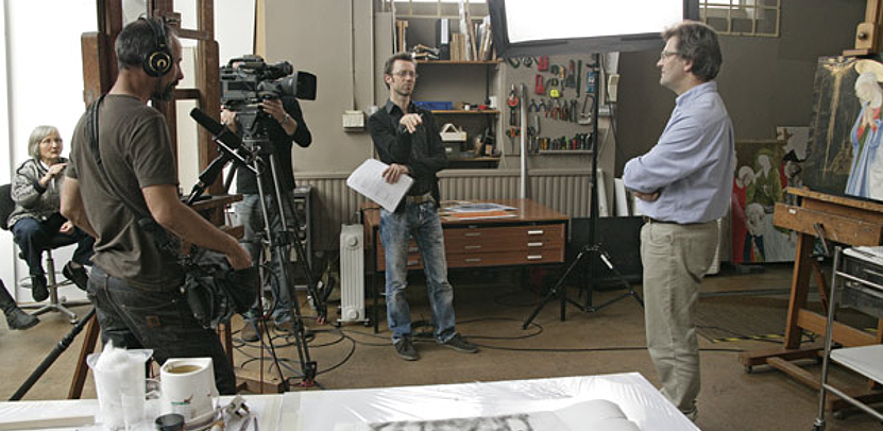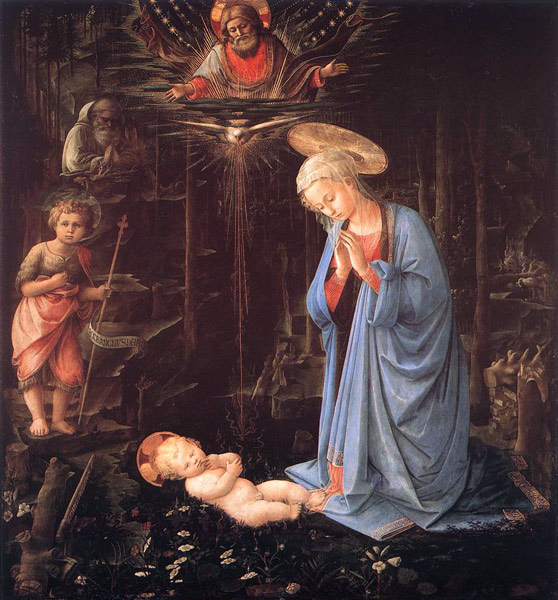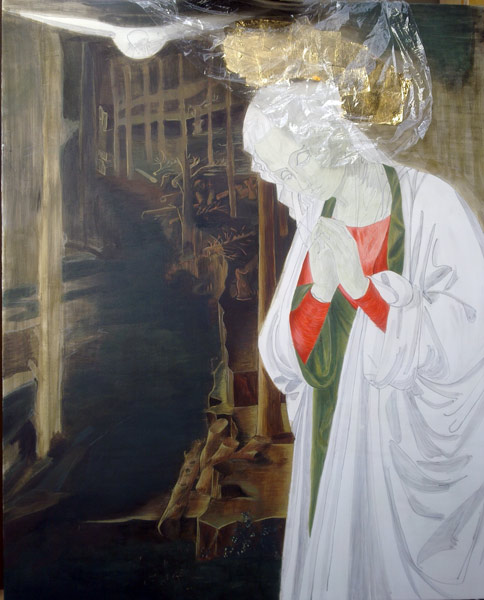Fra Filippo Lippi, Adoration of the Christ Child: A Reconstruction
by Christine Patrick and Krista Blessley
The Hamilton Kerr Institute was approached by Fulmar Television to create a detailed and historically accurate partial reconstruction of Filippo Lippi’s, Adoration of the Christ Child (Anbetung des Kindes), for a BBC television programme, The Private Life of a Christmas Masterpiece (screened on BBC 2 on 25 December 2010).
During filming ©Hamilton Kerr Institute
Adoration of the Christ Child by Filippo Lippi, painted c. 1459 depicts a kneeling Madonna adoring The Christ Child who lies on the ground of a dark wooded landscape. God the Father and the Holy Spirit appear above descending toward The Child. A penitential Saint Bernard and a young Saint John the Baptist are also present. Adoration of the Christ Child was originally painted to hang above the altar in the chapel of the Medici Palace in Florence, Italy, where a studio copy (c. 1470) currently hangs. The original is now displayed in Berlin at the Staatliche Museen zu Berlin Gemäldegalerie.
Filippo Lippi, Adoration of the Christ Child, Staatliche Museen zu Berlin Gemäldegalerie
The section of the painting chosen for the reconstruction was that of the Virgin and the Holy Spirit so as to include the varied gilding and tempera techniques found on the painting as a whole.
The panel
Although the panel used by Lippi for Adoration of the Christ Child was made from poplar,time limitations and availability prevented this for the reconstruction. Instead an oak panel, formed of two boards joined vertically was used.
The panel was prepared with layers of size and gesso, as described in Cennino Cennini’s publication Libro dell’Arte (dating c. 1400).
Underdrawing
A cartoon drawn from a full-scale photograph was transferred to the prepared gesso panel by tracing over the image laid over charcoal-coated paper. The unbound charcoal drawing was reinforced and ‘fixed’ with vine black bound in gum Arabic. Shading and hatching which had been made visible in an infrared image was also laid in with this ink. A white imprimatura layer had been identified on the Florentine copy of the painting so a translucent lead white egg tempera layer was applied. This increased the whiteness of the gesso and in turn the luminosity of the egg tempera medium. It also knocked back the ink underdrawing, which prevented it from showing through the finished image.
The paint layers
Egg tempera as a medium is very fast drying and allows only the application of small brushstrokes. It is not possible to work wet-in-wet. Using many fine, fairly transparent strokes enables the special ‘glow from within’ found in many egg tempera paintings. Adoration of the Christ Child shows high contrast between the dark imposing wooded background and the luminosity of the figures.
Lippi’s Adoration of the Child Christ was executed towards the end of the egg tempera period when experiments using oil as a medium were becoming more common. Lippi used a limited palette and although the pigments used have not been scientifically analysed or tested it is thought probable that his egg tempera palette may have consisted of malachite, yellow ochre, red lead, lead tin yellow, vermillion, ultramarine, terre verte, vine black and lead white. The paint was prepared by thoroughly grinding dry pigments in egg yolk and water. The transparent pigments madder lake and copper resinate were finely ground and bound in linseed oil.
The elaborate forested landscape of this painting plays a large role in generating an imposing atmosphere for the religious figures it holds. Lippi’s Adoration of the Christ Childwhich is one of a small series painted in this manner by Lippi is somewhat unusual and unlike earlier more primitive egg tempera religious themed paintings. The background was built up gradually with thin layers of egg tempered malachite mixed with vine black and applied relatively freely with a flat sable brush. Detail and form were gradually worked up using the traditional egg tempera technique with a small sable brush. Highlights were applied with lead tin yellow, yellow ochre and red lead. An oil layer of copper resinate, was applied to give saturation and depth. Two thin layers were applied with a flat sable brush to the background. Finally highlights which had been lost due to the oiling out layer were further enhanced using yellow ochre and lead tin yellow in egg tempera.
Undermodeling of the virgins face and hands
A verdaccio layer of terre verte and lead white underlies the flesh tones of the Virgin with shadows and mid-tones further worked up using a combination of earth tones. As with the blue drapery, five varying shades of skin tones were premixed and applied in thin layers to gradually work up shape and form. The red glow of the virgin’s cheeks was achieved using fine strokes of vermillion.
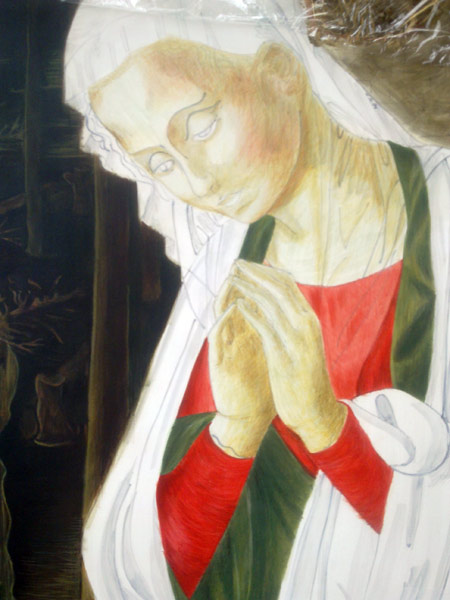
Undermodeling of the virgins face and hands
Gilding
Lippi used gold in three different ways in Adoration of the Christ Child. Water gilding, mordant gilding and the imitation of gold using egg tempera paint were all used to create a dazzling array of effects. The water gilded Virgin’s halo necessitated a very smooth gesso ground. The outline of the halo was incised into the ground and 8 layers of Armenian bole the consistency of milk were applied. Following burnishing, 3 layers of gold leaf were applied with the use of gilding water. Ruled rays spread non-uniformly from the inner to the outer ellipses of the halo, incised into the gold with the tip of a burnisher. Stippled punchwork delineates these ellipses within the halo as well as forming iridescent shimmering effects achieved with a rounded nail held firmly and allowed to spring back once hit with a hammer.
Mordant gilding was used for the rays emanating from the Holy Spirit and on the cuffs and edge of the Virgin’s robe. It appeared that there was a red underlayer to these areas and tests proved that the use of a bole underlayer facilitated a smoother surface on which to mordant gild and a better finish. The lines and dots to be gilded were painted with 2 layers of bole the consistency of cream. Time was limited and the mordant needed to reach a perfect point of tackiness within 24 hours to be gilded. Several recipes were tested and the final recipe consisted of stand oil, lead white, verdigris, bole and rosin, heated to 140°C. An isolating egg white varnish was applied to those areas painted with oil to prevent any unwanted adhesion of gold leaf to the paint. This release layer was of limited success and in laying the gold leaf over the mordant, adhesion also occurred in unwanted areas. Surplus gold was able to be removed with a dampened swab without damage to the underlying paint.
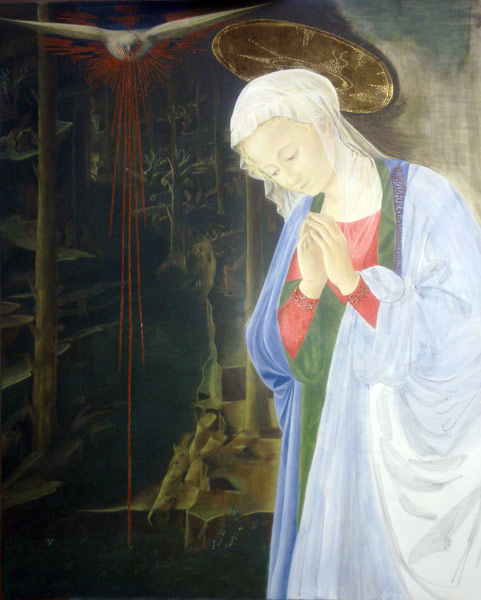
The finished reconstruction © Hamilton Kerr Institute
The “gold” dots on the Virgin’s robe as well as those that emanate from the Holy Spirit which twist around the gold rays and pierce into the ground are painted with lead-tin yellow bound in egg tempera. The play between these different types of gold application and the painted depiction of gold would have been enhanced in the painting’s original candlelit setting.

